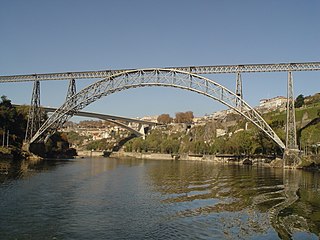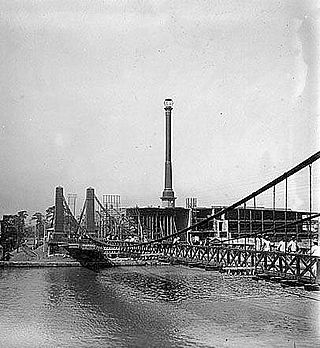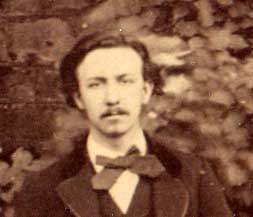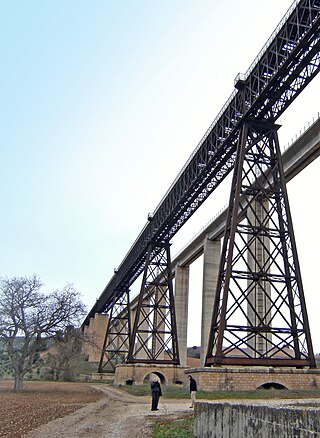
Alexandre Gustave Eiffel was a French civil engineer. A graduate of École Centrale des Arts et Manufactures, he made his name with various bridges for the French railway network, most famously the Garabit Viaduct. He is best known for the world-famous Eiffel Tower, designed by his company and built for the 1889 Universal Exposition in Paris, and his contribution to building the Statue of Liberty in New York. After his retirement from engineering, Eiffel focused on research into meteorology and aerodynamics, making significant contributions in both fields.

Ronda is a municipality of Spain belonging to the province of Málaga, within the autonomous community of Andalusia.

The Vizcaya Bridge is a transporter bridge that links the towns of Portugalete and Las Arenas in the Biscay province of Spain, crossing the mouth of the Nervion River.

Alberto de Palacio y Elissague (1856–1939) was a Spanish engineer and architect born in Sare and grown up in Gordexola.

Maria Pia Bridge is a railway bridge built in 1877, and attributed to Gustave Eiffel, situated over the Portuguese Northern municipalities of Porto and Vila Nova de Gaia.

Puente Aranda is the 16th location of the Capital District of the Colombian capital city, Bogotá. It is located in the center part of Bogotá. This district is mostly inhabited by lower middle and working class residents. The district was named after an old bridge in the hacienda of Juan Aranda over the "Chinúa River", now called the San Francisco River, that dates to the 16th century. Puente Aranda has 1,724 hectares of area which are almost entirely urban. This locality has more than 300,000 inhabitants, 5% of the total urban area inhabitants of Bogota.

Láchar is a municipality in the province of Granada, in Spain. The village of Láchar lies in Granada's floodplain amid poplar forests, arable farmland and olive groves. The surrounding countryside, and particularly the pine forest known as Los Pinares, lends itself to outdoor sports and recreational activities, and there is also a long tradition of partridge shooting.

A parabolic arch is an arch in the shape of a parabola. In structures, their curve represents an efficient method of load, and so can be found in bridges and in architecture in a variety of forms.

The Puente Colgante, originally called Puente de Clavería, was a suspension bridge that connected the Manila districts of Quiapo and Ermita across the Pasig River in the Philippines. Designed by Matia, Menchacatorre and Cía. and completed in 1852, it was the first modern wire-cable suspension bridge in Asia and the first toll bridge of its kind in the Philippines. It was replaced by the Quezon Bridge in 1939.

The Vega de Granada is a comarca in the province of Granada, southeastern Spain. The name refers to the plain near the city of Granada.

Émile Nouguier was a French civil engineer and architect. He is famous for co-designing the Eiffel Tower, built 1887–1889 for the 1889 Universal Exposition in Paris, France, the Garabit viaduct, the highest in the world at the time, near Ruynes-en-Margeride, Cantal, France, and the Faidherbe Bridge over the Sénégal River in Senegal.

Hacho Bridge is a former railway bridge in Granada which was part of the Linares Baeza–Almería railway through the Sierra Nevada, Spain. It remains the longest iron viaduct on the Spanish rail network. The bridge is maintained by Renfe.

The Puente de Alcántara is a Roman arch bridge in Toledo, Spain, spanning the River Tagus. The word Alcántara comes from Arabic القنطرة (al-qanţarah), which means "arch".
Eiffel Bridge can refer to:
The following is a timeline of the history of the city of Seville, Andalusia, Spain.

A bridge tower was a type of fortified tower built on a bridge. They were typically built in the period up to early modern times as part of a city or town wall or castle. There is usually a tower at both ends of the bridge. During the 19th century, a number of bridge towers were built in the Gothic Revival style – Tower Bridge in London is perhaps the best known example; however, many original medieval towers survive across Europe.

The Caños de Carmona is a Roman aqueduct built during the first century BC to supply water from a spring in the ancient Roman city of Irippo –current Alcalá de Guadaíra– to the ancient Roman city of Hispalis –current Seville–, both in the ancient Roman province of Hispania Ulterior –current Spain–. It was later renovated and partially re-built in the twelfth century by the Almohads and it was fully operational until its demolition in 1912. Some sections survived the demolition and remain standing today.

The Decauville railway at Láchar was an 8.3 km (5.2 mi) long narrow-gauge railway with a gauge of 600 mm from Íllora-Láchar railway station via the Eiffel Bridge to the sugar mill in Láchar.

The Puente Ingeniero Ernesto Uriegas, best known as the Puente de Fierro, is a twin-span bridge found along Vía Morelos Avenue, in San Cristóbal, Ecatepec de Morelos, State of Mexico. The bridge was built to cross the Gran Canal del Desagüe that surrounds Mexico City. The origins of the construction of the bridge tend to differ depending on the source as there are few records of the bridge beyond undated pictures. One of the stories says that it was completed in 1896 to be operated by the National Railroad Company. There is also a persistent legend about its origins that mentions that Gustave Eiffel, at the request of president Porfirio Díaz, designed the bridge in the 1870s. It was later adapted into a provisional vehicle bridge and eventually replaced with an adjacent larger vehicular bridge. In 2000, the local government remodeled the space into a museum, which would last 16 years. Since then, the bridge has been abandoned and has received partial maintenance.



















